Alina Korneeva vs Anastasia Zakharova: Caldas da Rainha Final Analysis (ITF W100)
Returns, "serve+1s" and backhands provided the separation as Korneeva made a triumphant return to the ITF World Tour.
Exactly one year ago, everything suggested Alina Korneeva (WTA #233) had played in Caldas da Rainha her last event on the ITF World Tour for the forseeable future.
The promising teenager looked poised to graduate to the main Tour after winning 14 of 16 matches in her last 3 summer events of 2023 that resulted in a title at W100 Figueira da Foz, a runner-up trophy at W80 Le Neubourg (held 2 championship points) and a semi-final at W60 Caldas da Rainha.
Such prediction only got stronger when Korneeva made her Major debut at this year’s Australian Open. Coming through qualifying, the (at the time) 16-year-old defeated Sara Sorribes Tormo in round 1 before falling to 10th-seed Beatriz Haddad Maia.
Soon after, however, Korneeva’s ascension was halted by a left wrist problem that required surgery and sidelined her for over 6 months.
Out since February, Korneeva returned to action last week at WTA 250 Monastir. She won her first match, then lost to Maria Timofeeva in the final qualifying round. But Korneeva’s work in Tunisia wasn’t over. Playing alongside Anastasia Zakharova, the pair reached the doubles final, losing by the closest of margins - 8:10 in the match tie-break.
One week later, partners became opponents in the Caldas da Rainha final with the winner guaranteed to claim a second ITF W100 trophy, joint-biggest career title to date for any of them. As already mentioned, Korneeva was crowned in 2023 at W100 Figueira da Foz and, coincidentally, Zakharova (WTA #146) was the player succeeding this year as champion in the Portuguese coastal city.
After saving a couple of break points in the opening game of the final, Korneeva was never bothered again on serve. She dominated the first set and grabbed the only break of the second set in the 9th game to defeat Zakharova by 6-1, 6-4. An outcome that sealed Korneeva’s triumphant return to the ITF World Tour, exactly one year after her last participation, and secured a 4th career pro title.
A deeper look at the Caldas da Rainha final revealed 3 key factors:
Returns
“Serve+1s”
Backhand performances
The first 2 factors combined to give Korneeva a massive 24-point advantage just from 1-shot and 2-shot rallies. In these 2 rally lengths combined, Korneeva won 33 points and lost 9 (marked by red box, below). The resulting 24-point gap exceeded by 4 points the final winning margin that stood at 20 (62-42).
The difference in 1-shot rallies, corresponding to serves that were not returned, was mostly created by return errors. Zakharova accumulated 17 missed returns while Korneeva only had 7.
Zakharova loves to take her returns early and inside the court. Below you can see her hitting a 1st serve return.
But this aggressive stance didn´t match up well against Korneeva’s serve, on the day. Apart from a shaky start (2 double faults in her first 4 serve points), Korneeva served well and got good placement and sufficient kick on 2nd serves to trouble Zakharova.
Zakharova made no adjustments and by the end of the match totalled 17 return errors, including 7 against 2nd serves. In contrast, Korneeva missed a single 2nd serve return.
Also noticeable was the difference in backhand return errors. Zakharova had 11 while Korneeva only had 1.
Return errors
vs 1st serves: Korneeva 6 / Zakharova 10
vs 2nd serves: Korneeva 1 / Zakharova 7
Forehand: Korneeva 6 / Zakharova 6
Backhand: Korneeva 1 / Zakharova 11
The gap in 2-shot rallies was a mix between Korneeva’s quality returns and contrasting “serve+1” performances.
Korneeva fired 4 return winners and several other returns that put Zakharova under pressure. As a result, Zakharova generated just 1 “serve+1” winner while missing 10 “serve+1” shots. Once again, the bulk of those mistakes (8 of 10) came from the backhand side.
On the other side of the net, Korneeva enjoyed a vastly superior “serve+1” performance. She struck 4 “serve+1” winners and made just 1 error.
“Serve+1” Performance
Korneeva: 4 winners / 1 error = +3
Zakharova: 1 winners / 10 errors = -9
Overall, the following stat line speaks loud and clear: 9 backhand errors to 33.
When it came to backhands ending the point, Korneeva had a neutral differential (9 winners and 9 errors), good for a gigantic 28-point advantage in comparison to Zakharova’s -28 (5 winners and 33 errors).
Forehand Performance
Korneeva: 5 winners / 17 errors = -12
Zakharova: 7 winners / 13 errors = -6
Backhand Performance
Korneeva: 9 winners / 9 errors = 0
Zakharova: 5 winners / 33 errors = -28
Korneeva’s backhand may be her best shot and she showed it once again.
From that wing, the 17-year-old fired 9 winners and 4 shots that forced errors while hitting just 4 unforced errors and 9 total errors.
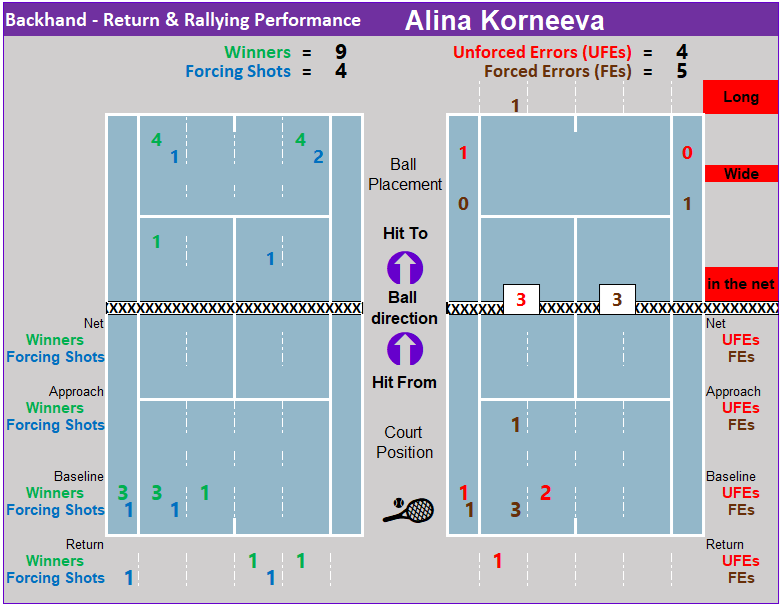
In contrast, Zakharova’s backhand was off. She missed returns, groundstrokes, volleys and an approach for 23 backhand unforced errors and 33 total errors.
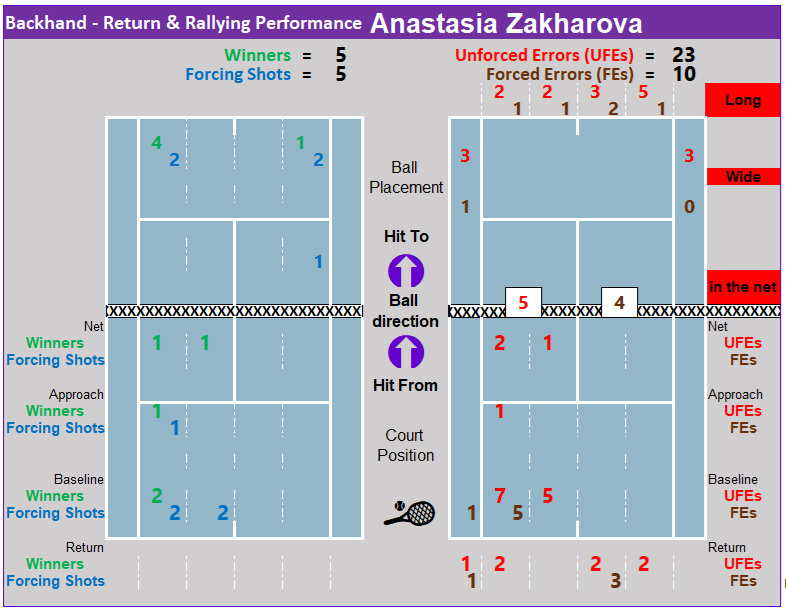
One final remark to end.
During the match, Zakharova didn’t adjust her return position. But she certainly made a gameplan change for the second set.
After winning just 10 of 27 rallies played in set 1, Zakharova increased her net attacks to 11.
Zakharova net points
Set 1: 2-for-4 (50%)
Set 2: 7-for-11 (64%)
With 7 of 11 net points won, Zakharova improved to a near split of second set rallies (won 20, lost 22). Such relative parity accentuated how costly Zakharova’s 8 return errors in the second set turned out to be.
Alina Korneeva (WTA #233) vs Anastasia Zakharova (WTA #146, seed 4)
2024 Caldas da Rainha Final - Match Data
Set by Set Stats
Strategy Stats
Rally Length
Serve and Return
Winners and Errors (returns and rally shots)
Strokes Breakdown

Direction of winning shots and unforced errors (only groundstrokes)

1st Serves
2nd Serves
Return & rallying performance
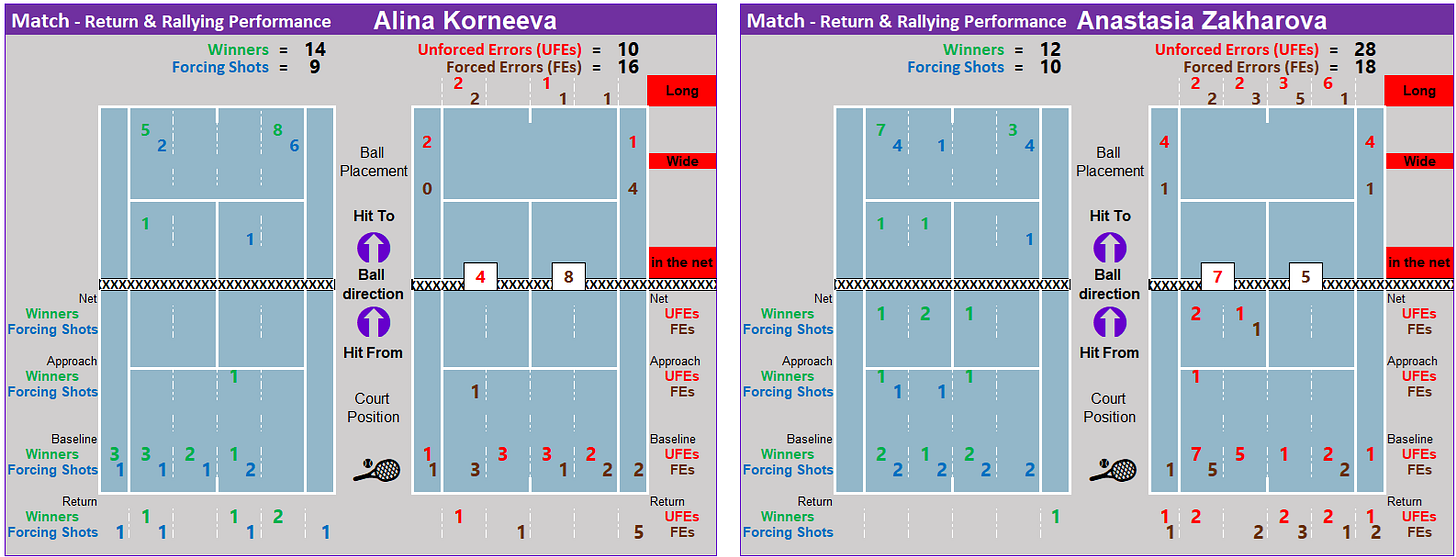
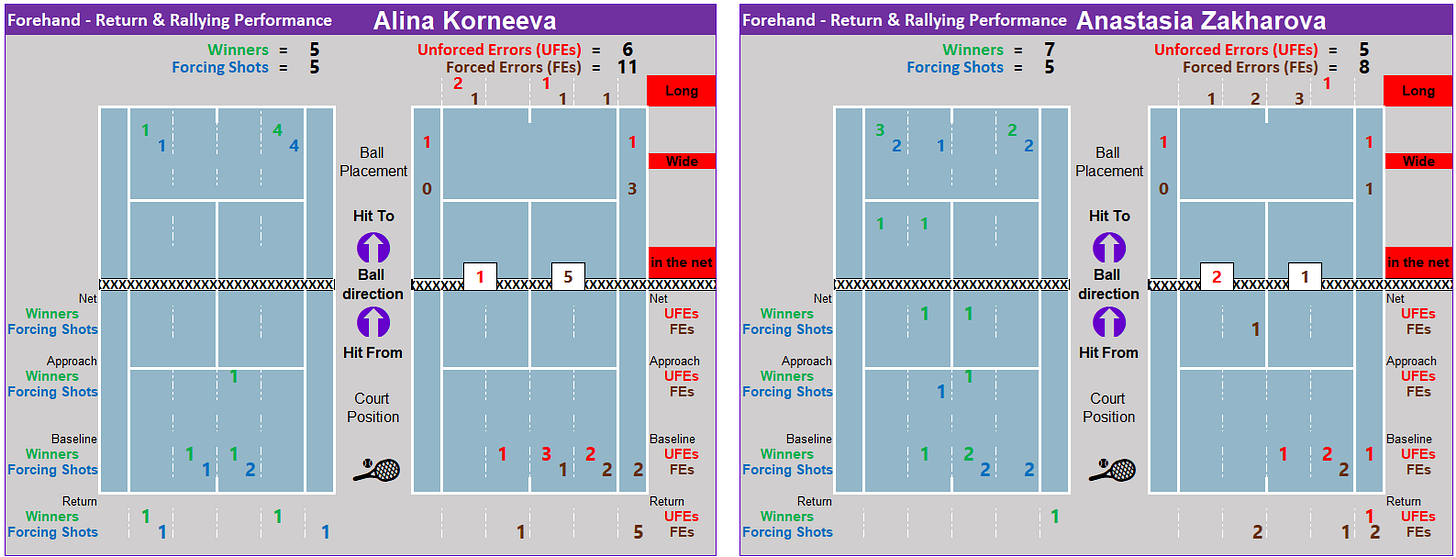
Points won breakdown
This final section gives a last, broader look at the match by presenting how each player won points. Points are listed according to their frequency (highest to lowest) and are named in relation to the last touch on the ball. For simplicity, groundstrokes hit from the 5th shot onwards are grouped together.
Breakdown by side (FHs or BHs)
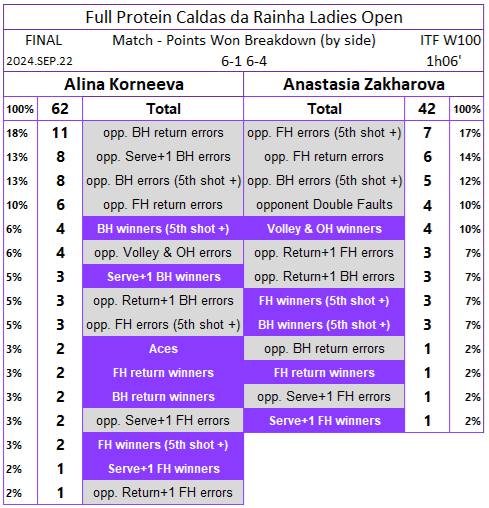
Breakdown by error type (UFEs or FEs)
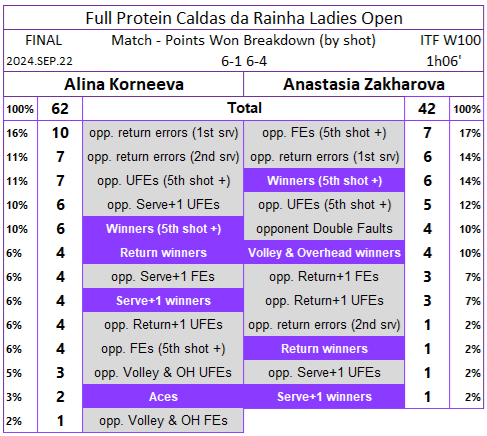
To find out more about the stats published here, please visit the following post.
Even though they follow the same criteria used on all major tennis events, they are not official WTA or ITF stats. They are collected through our own rigorous video analysis.
Thanks for reading!
— Tennis Inside Numbers














